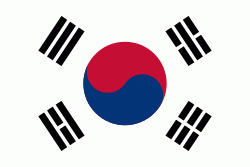Jongno-gu
Jongno District (종로구) is a district (구) in central Seoul, South Korea. It takes its name from a major local street, Jongno, which means "Bell Road".
Jongno District has been the center of the city for 600 years, since it is where the Joseon dynasty established its capital city. Jongno District is commonly referred to as the face and heart of Korea because of its important roles in the politics, economics, culture, and history as the capital city. Jongno District is home to palaces in which the kings used to reside and work, such as Gyeongbok Palace, Changdeok Palace, Changgyeonggung and Unhyeon Palace. The South Korean president's former residence, the Cheongwadae, is also located in the Jongno District.
Due to its rich history, Jongno District attracts visitors and tourists, especially those interested in Korean history and culture. These include the restored Cheonggyecheon stream, the traditional neighborhood of Insa-dong, and the Jongmyo shrine. Art Center Nabi and Gahoe Museum, a relics museum is also located in the district. A number of colleges and universities are located here; these include the main campuses of Sungkyunkwan University and Baehwa Women's College.
Jongno District is also home to Jogyesa, the chief temple of the Jogye Order of Korean Buddhism.
The area is also home to the Gwanghwamun Plaza, a public open space on Sejongno, and is part of the Seoul Metropolitan Government's plans for environmentally friendly renovation projects such as the Cheonggye Stream and Seoul Plaza. It is also of historical significant as the location for royal administrative buildings and features statue of the Admiral Yi Sun-sin of Joseon Dynasty and statue of King Sejong the Great of Joseon.
Jongno District has been the center of the city for 600 years, since it is where the Joseon dynasty established its capital city. Jongno District is commonly referred to as the face and heart of Korea because of its important roles in the politics, economics, culture, and history as the capital city. Jongno District is home to palaces in which the kings used to reside and work, such as Gyeongbok Palace, Changdeok Palace, Changgyeonggung and Unhyeon Palace. The South Korean president's former residence, the Cheongwadae, is also located in the Jongno District.
Due to its rich history, Jongno District attracts visitors and tourists, especially those interested in Korean history and culture. These include the restored Cheonggyecheon stream, the traditional neighborhood of Insa-dong, and the Jongmyo shrine. Art Center Nabi and Gahoe Museum, a relics museum is also located in the district. A number of colleges and universities are located here; these include the main campuses of Sungkyunkwan University and Baehwa Women's College.
Jongno District is also home to Jogyesa, the chief temple of the Jogye Order of Korean Buddhism.
The area is also home to the Gwanghwamun Plaza, a public open space on Sejongno, and is part of the Seoul Metropolitan Government's plans for environmentally friendly renovation projects such as the Cheonggye Stream and Seoul Plaza. It is also of historical significant as the location for royal administrative buildings and features statue of the Admiral Yi Sun-sin of Joseon Dynasty and statue of King Sejong the Great of Joseon.
Map - Jongno-gu
Map
Country - South_Korea
 |
 |
| Flag of South Korea | |
The Korean Peninsula was inhabited as early as the Lower Paleolithic period. Its first kingdom was noted in Chinese records in the early 7th century BCE. Following the unification of the Three Kingdoms of Korea into Silla and Balhae in the late 7th century, Korea was ruled by the Goryeo dynasty (918–1392) and the Joseon dynasty (1392–1897). The succeeding Korean Empire (1897–1910) was annexed in 1910 into the Empire of Japan. Japanese rule ended following Japan's surrender in World War II, after which Korea was divided into two zones; a northern zone occupied by the Soviet Union and a southern zone occupied by the United States. After negotiations on reunification failed, the southern zone became the Republic of Korea in August 1948 while the northern zone became the communist Democratic People's Republic of Korea the following month.
Currency / Language
| ISO | Currency | Symbol | Significant figures |
|---|---|---|---|
| KRW | South Korean won | â‚© | 0 |
| ISO | Language |
|---|---|
| EN | English language |
| KO | Korean language |















